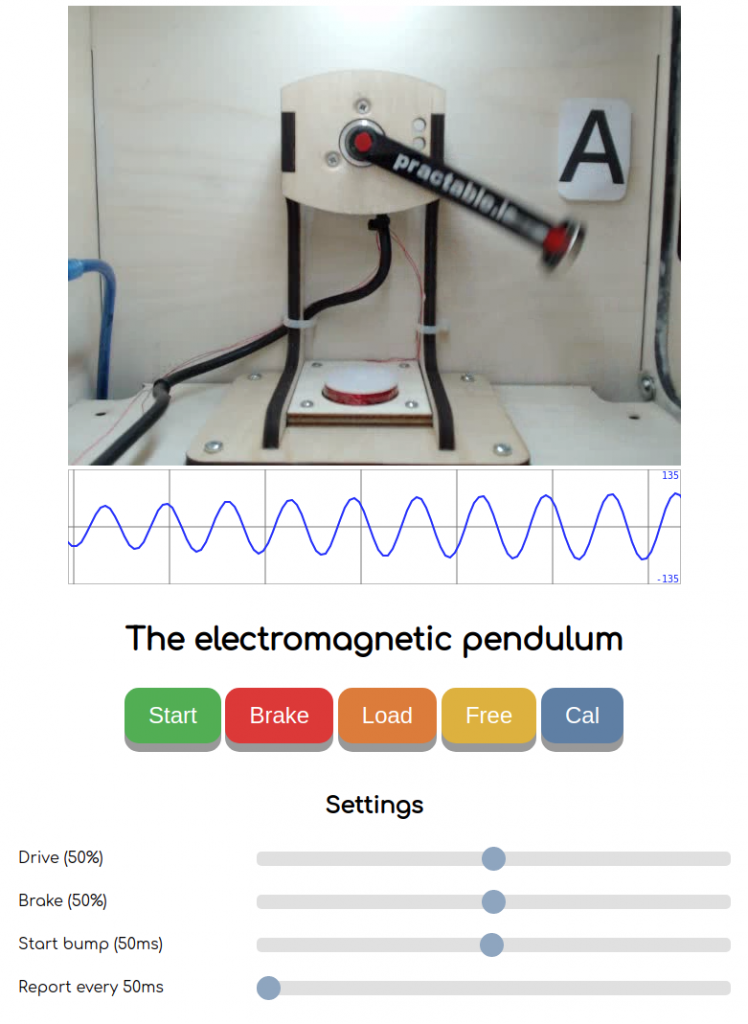Ah, happy days. I’ve twenty penduino experiments stacked in my living room. They’re simple but important experiments. You turn on an electromagnet to make the pendulum move.

The swinging pendulum is a classic introductory example of simple harmonic motion. The apparent simplicity of pendulums belies deep roots in our scientific history, having played important roles in:
- telling time;
- navigating around the world;
- finding the density of the earth; and
- proving the earth rotates.
Thanks to pendulums, we know the earth is solid, rotating, how to get around it, and what time it is when we get to our destination. So what does a pendulum actually look like in action?
Recording the angle of the pendulum produces a sine wave, linking this fundamental trigonometric function with one of the most fundamental forms of motion in the physical world. In this example, the height of the swing is building up, so the amplitude of the sine wave is gradually increasing from left to right in the plotted data. You can see the rounded peaks and troughs in the data because because the pendulum has to slow down to change direction (the same way a ball thrown in the air does).

These electromagnetic pendulums also allow you to explore fundamental electromagnetics principles such as Lenz Law . The pendulum stops swinging faster if you “load” it by short-circuiting the electromagnet. If all that wasn’t enough physics, then we could add a second joint to the pendulum, and explore chaos. Double-jointed pendulums are an experiment for another day, though! I’ll leave you to explore the physics of pendulums some more on your own if you wish, while now I’ll move on to the remote labs stuff.
Remote labs at scale
Setting up a remote lab with lots of copies of the same experiment requires a slightly different mind set to setting up just one experiment. For a start, you don’t want to be repeating the same tasks over and over again by hand, for each of the copies of the experiment. Not only is it tedious, but it also increases the chance of making an error. Secondly, there are ways of thinking about pools of experiments that help your laboratory be more resilient to the vicissitudes of hardware.
I’ll pick up more on these themes in future posts – but for now, I am excited to have a working batch of 20 pendulums to develop and test out the software infrastructure with.
Acknowledgements
My Dad (Alex) designed the original laser-cut wooden box for me over one Christmas holiday 2018-2019. Here’s one of the original boxes from the first run of four.
This year the Head of School Prof Conchúr Ó Brádaigh approved the spend to make this large batch of boxes (my thanks also to my Director of Discipline Dr James Hopgood for his role in supporting this). Chris Sturgeon’s technical team jumped on the task of getting the large batches of boxes made up, with Andrew Brown designing the new-look pendulum, tweaking the boxes for laser production, and coping with the tedium of supervising the laser over and over again (even when things got smokey). Together with Calum Melrose, they bashed out over fifty boxes and forty pendulum kits so far and are now working on another thirty controls experiments. The pendulum design originated from Tony Gasparovic. Michael Merlin suggested a new control scheme for the pendulums, which achieves variable swing height and braking. David Reid converted my Veroboard version into a PCB design, which Alasdair Christie and Iain Gold populated and cabled. Richard Scott and Doug sorted out the lighting (easiest lighting setup with the connectors Doug chose). A number of others have been helping other aspects of this programme along too, and I thank you too – more on you later!



